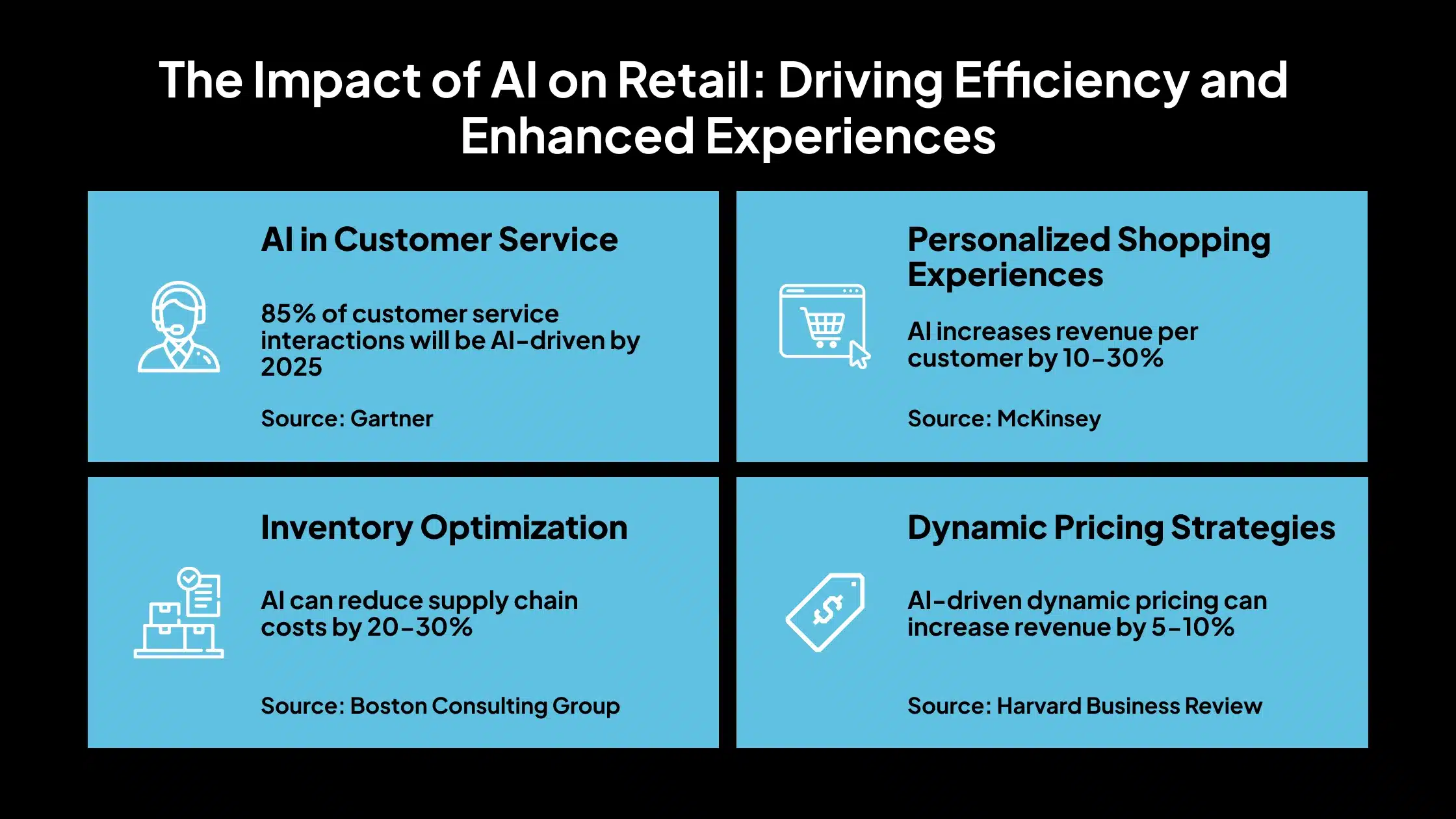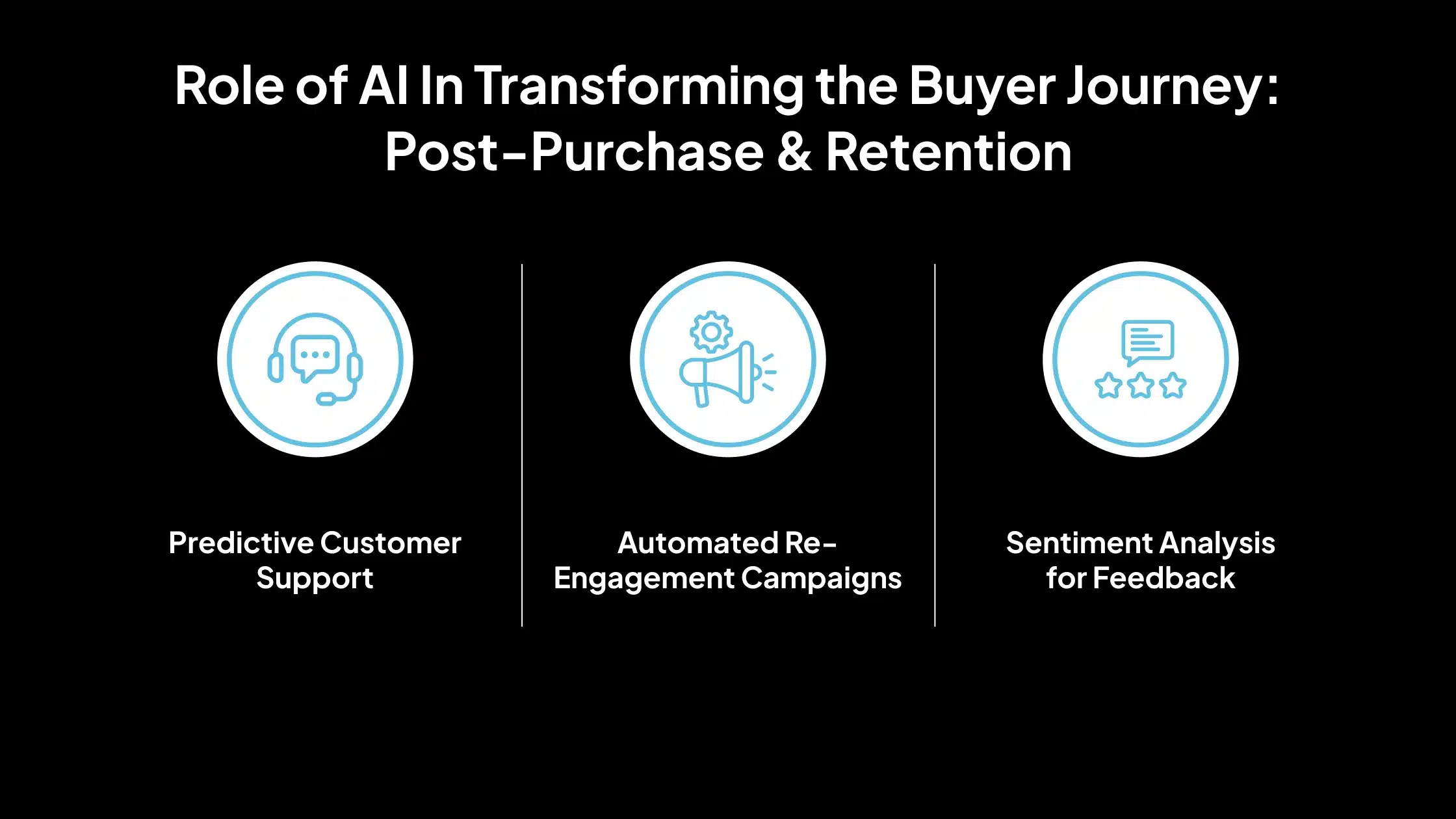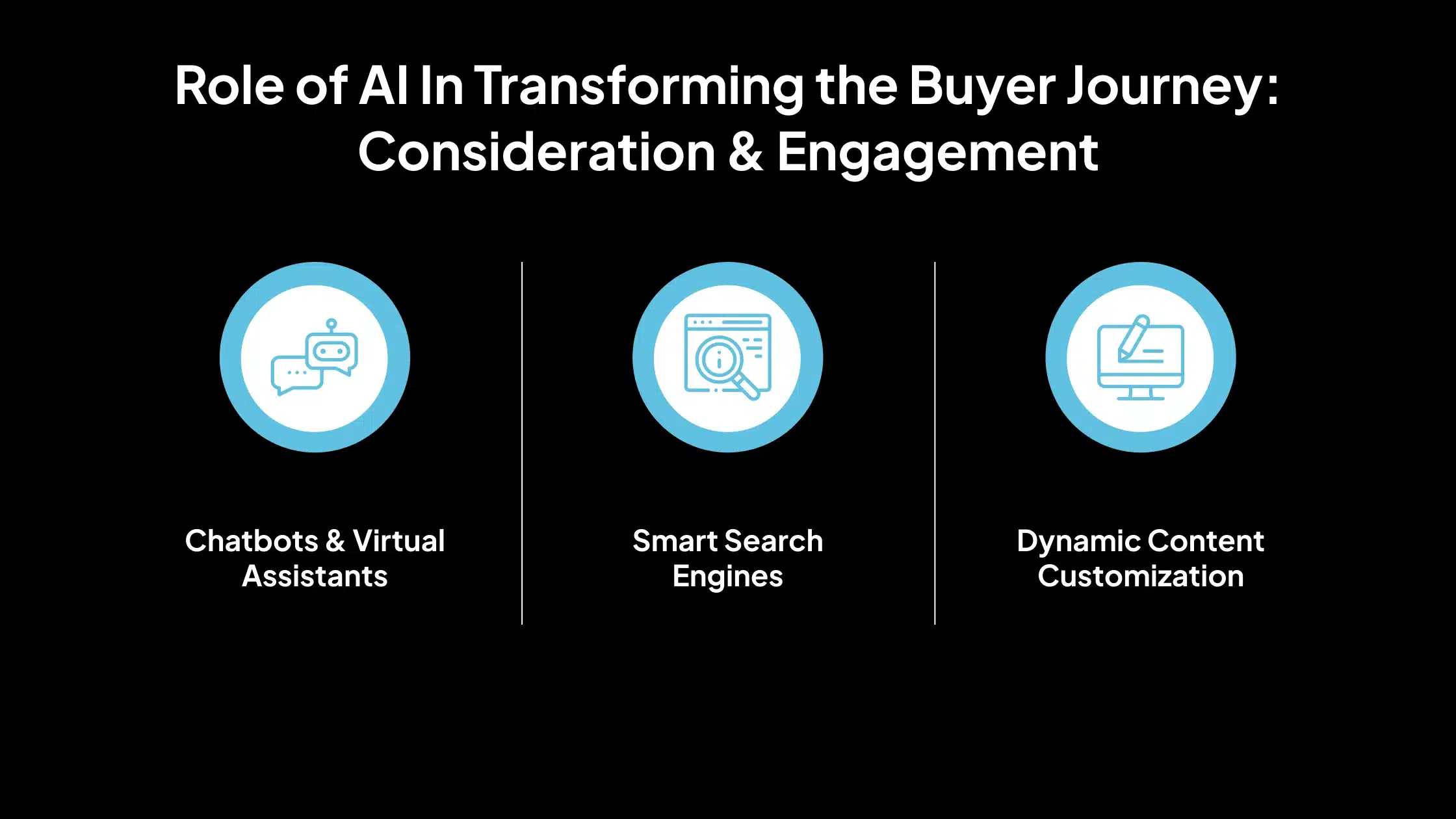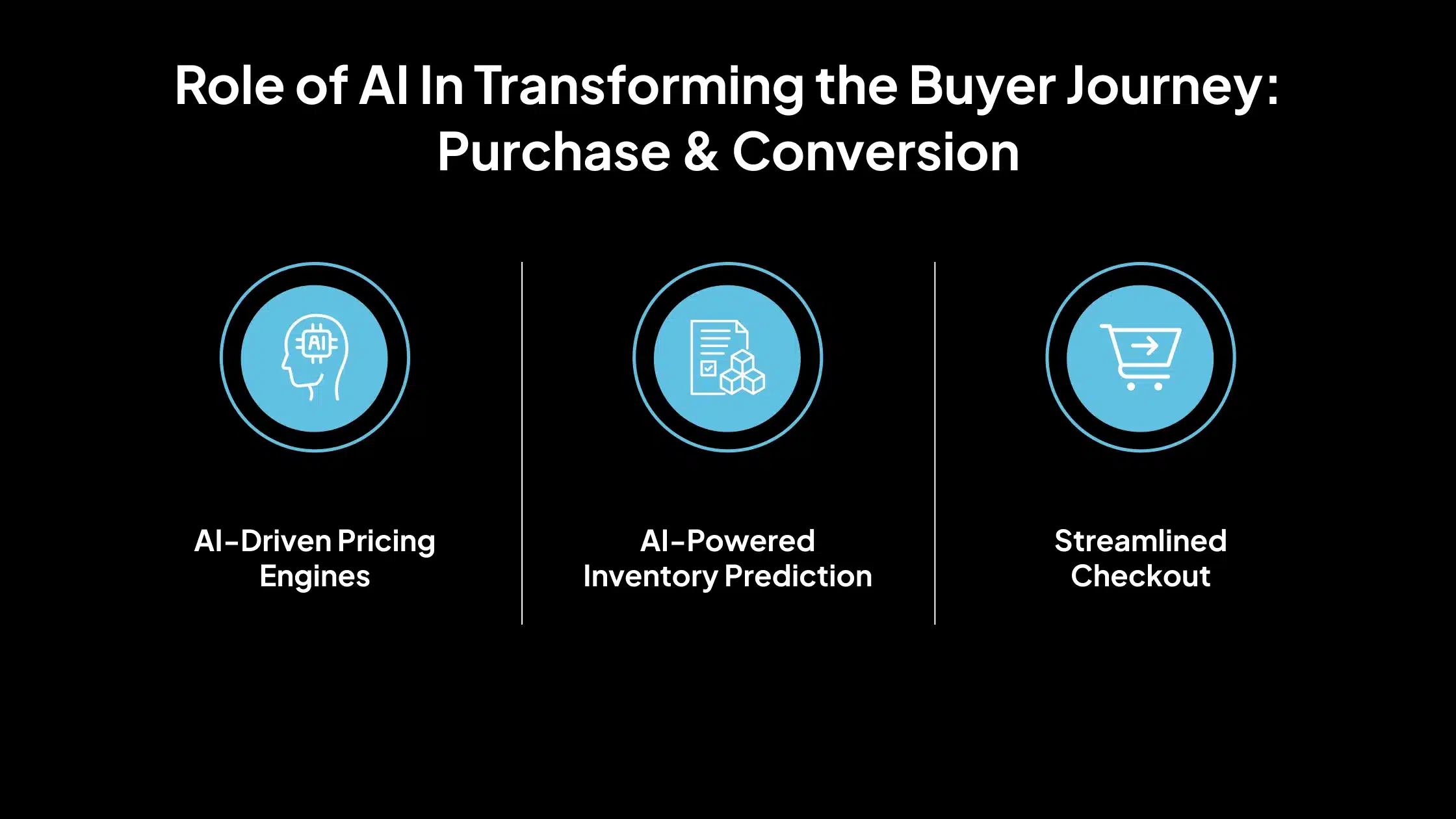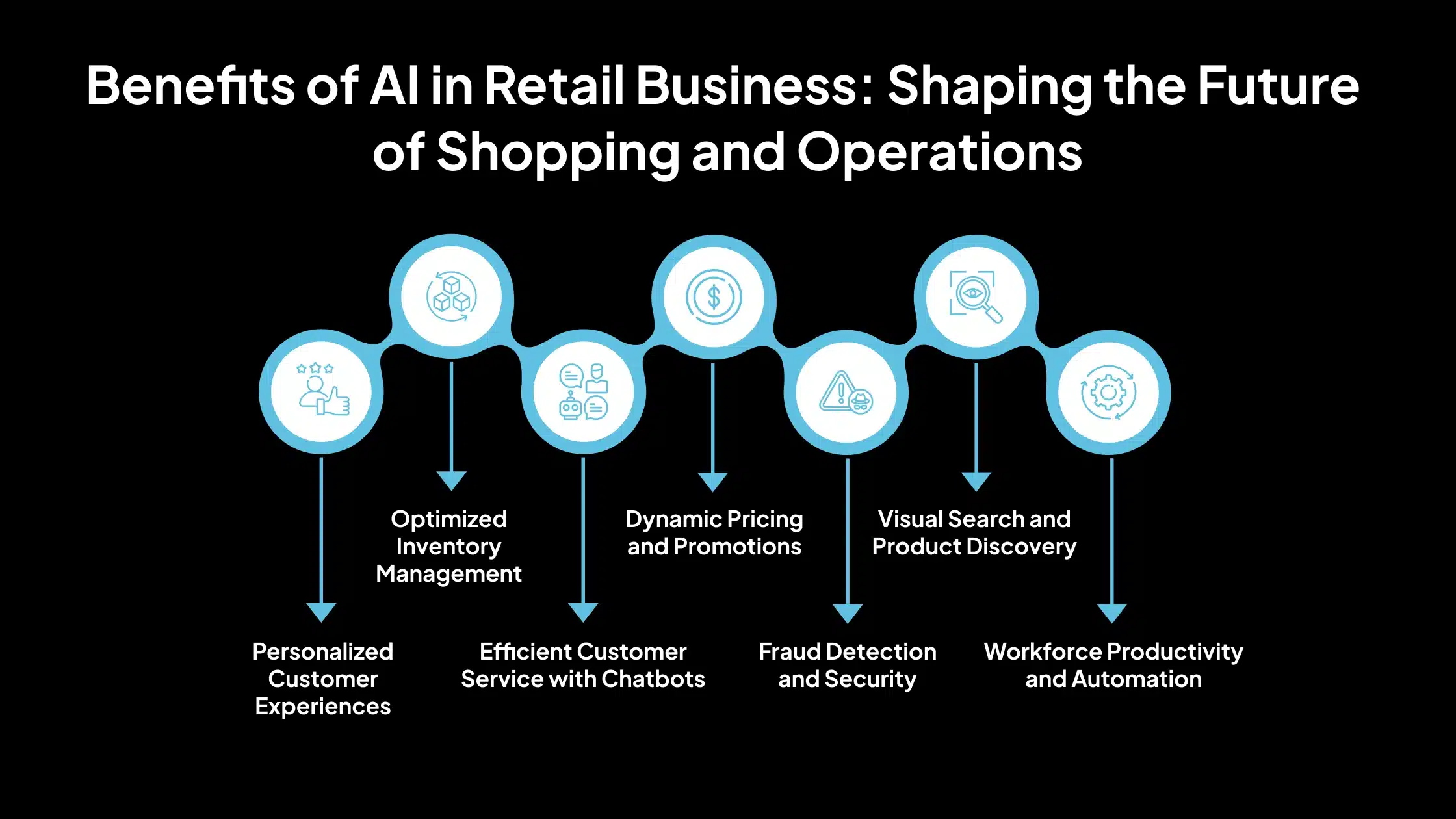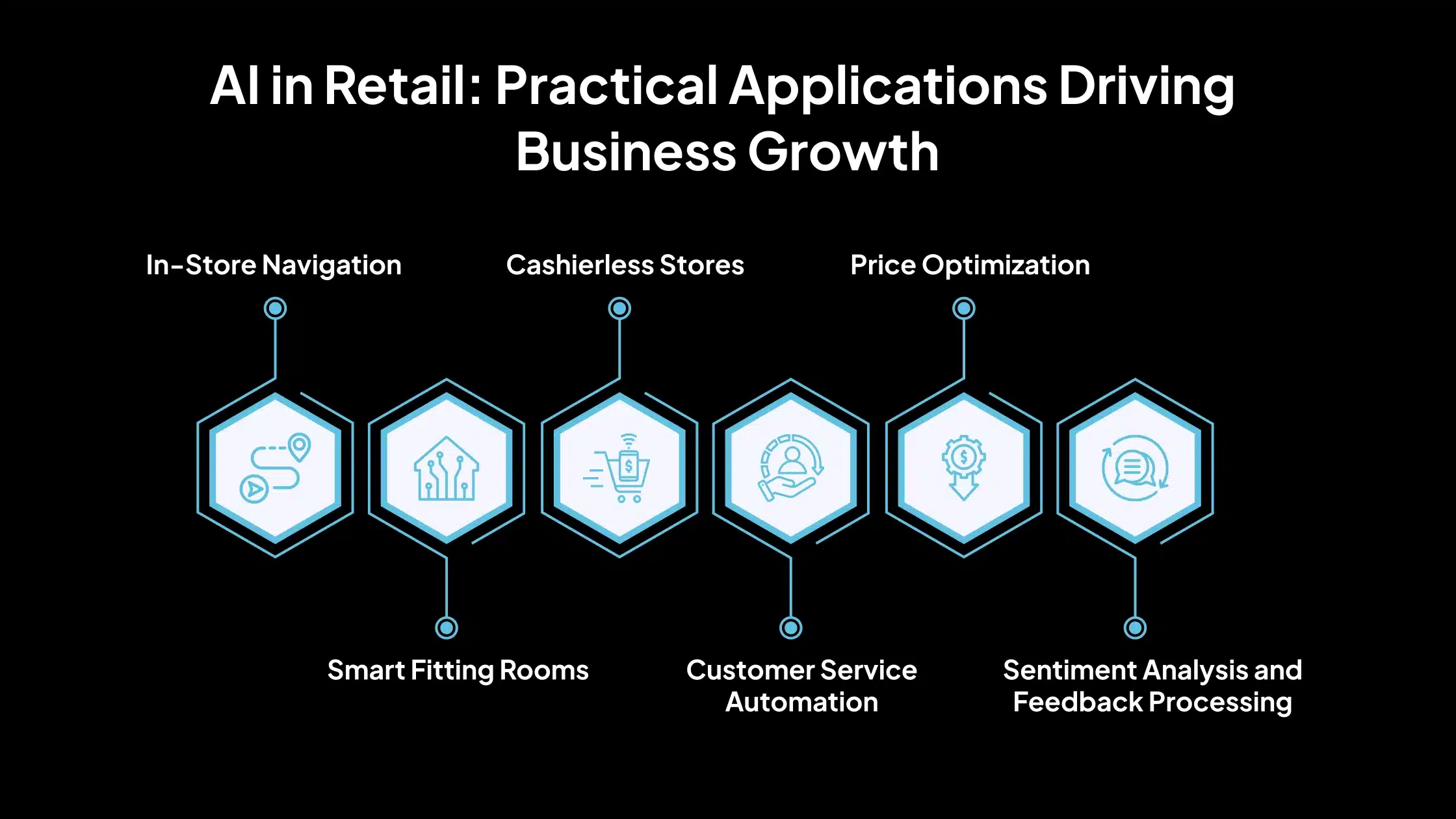Why is retail getting more complicated to manage, even with access to more data than ever?
Today’s retailers are facing mounting pressure from multiple sides. Unpredictable demand, rising operational costs, delayed supply chains, and increasing customer expectations have made it difficult to stay profitable and competitive. Inventory mismatches lead to stockouts or overstocking. Marketing efforts often lack precision, resulting in low conversions.
Manual workflows slow down fulfillment. Despite having access to data, many businesses still struggle to make timely, informed decisions.
AI in retail commerce enables businesses to move from reactive operations to a proactive strategy. By analyzing vast amounts of data in real time, AI helps retailers predict customer behavior, optimize inventory, personalize marketing, automate routine tasks, and improve pricing accuracy. It eliminates guesswork and brings consistency to decisions that once depended heavily on intuition.
In this blog, we’ll explore how AI in retail commerce directly addresses the challenges retailers face today. From more intelligent demand forecasting to seamless customer experiences and more agile supply chains, AI is no longer a future consideration but a current necessity.
AI in Retail: Streamlining Processes and Improving Customer Engagement
AI in retail allows businesses to use real-time data and insights to automate processes, innovate, and meet evolving customer expectations. AI is revolutionizing retail by driving improvements across multiple areas:
- Computer vision provides insights into customer behavior, streamlines inventory management, and supports frictionless checkout and loss prevention features.
- Machine learning optimizes inventory practices, forecasts demand, and personalizes shopping experiences.
- Conversational AI enhances customer service through personalized assistance, streamlining tasks like drive-through orders or online inquiries.
- Natural Language Processing (NLP) enables retailers to analyze customer feedback, improve product descriptions, and automate customer service through chatbots and voice assistants.
- Robotic Process Automation (RPA) automates repetitive tasks like order processing and data entry, freeing up resources for more strategic work.
- Augmented Reality (AR) offers virtual try-ons and interactive shopping experiences, allowing customers to visualize products before purchase.
Retailers adopting these technologies can improve efficiency and create deeper, more personalized customer interactions, positioning themselves to thrive in a competitive, tech-driven market.
The Impact of AI on Retail: Driving Efficiency and Enhanced Experiences
AI rapidly changes the retail industry, enhancing customer experiences and streamlining operations.
Gartner predicts that by 2025, 85% of customer service interactions will be AI-driven, improving efficiency and reducing costs. AI-powered chatbots offer 24/7 support, instantly answering customer queries and boosting satisfaction.
Retailers are also using AI to personalize shopping experiences. By analyzing customer data, AI provides tailored recommendations, helping retailers see a 10-30% increase in revenue per customer, according to McKinsey.
Additionally, AI helps manage inventory by predicting demand, which Boston Consulting Group reports can reduce supply chain costs by 20-30%.
AI is also improving pricing strategies. Dynamic pricing algorithms adjust prices based on factors like demand and competition, leading to a 5-10% increase in revenue, as stated by Harvard Business Review. Innovations like AI-driven fitting rooms and cashierless stores enhance the in-store experience by saving time and improving convenience.
AI in retail commerce boosts efficiency, increases revenue, and improves customer satisfaction, making it a crucial tool for businesses aiming to stay competitive in the digital age.
Transforming the Buyer Journey: How AI Drives Engagement and Conversion
1. Awareness & Discovery
At the top of the buyer journey, the goal is to help potential customers discover products that match their needs or interests, even before they realize what they’re looking for.
AI can support this stage by identifying intent, matching preferences, and anticipating trends. Below are the applications of AI that businesses can adopt during the awareness and discovery phase:
Personalized Product Recommendations
AI can suggest relevant products to customers based on their browsing behavior, past purchases, or items viewed by similar users. AI increases engagement and encourages discovery by showing products that match individual preferences.
How It Works
Collaborative filtering recommends items by comparing user behavior across a broad customer base (e.g., “Customers who bought X also bought Y”). Content-based filtering suggests products based on a customer’s activity and product characteristics (e.g., similar colors, brands, or categories).
Personalized recommendations can increase average order value and improve conversion rates by helping users find products they are more likely to buy.
AI in Visual Search
Visual search allows customers to upload images and find similar or matching products directly from a retailer’s inventory. Shoppers often struggle to describe what they want, but visual search removes this barrier by allowing them to search with images instead of text.
How It Works
Customers upload a photo or screenshot (e.g., a dress they saw online). AI compares visual features, such as color, shape, and texture, to items in the catalog and displays close matches.
This tool improves search accuracy and enhances the user experience, particularly in fashion, home décor, and accessories, where visual appeal is critical.
Social Listening and Trend Forecasting
AI can track and analyze customer conversations across social media, forums, and review platforms to identify emerging preferences and market shifts. Staying ahead of consumer trends helps retailers remain competitive and launch products that meet current demand.
How It Works
Natural language processing (NLP) and sentiment analysis tools monitor mentions of products, brands, and keywords. AI clusters the data to highlight what topics or items are gaining traction or losing relevance.
Social listening insights help marketing and product teams improve inventory, messaging, and promotional timing decisions. It also enables early identification of trends before they peak, allowing faster go-to-market strategies.
2. Consideration & Engagement
In the consideration phase, customers evaluate their options and engage more deeply with your brand. AI tools can help nurture this engagement and make the shopping process smoother.
Chatbots & Virtual Assistants
AI-driven chatbots and virtual assistants provide 24/7 assistance to customers, answering their questions, guiding them through the shopping process, and even suggesting products.
AI-powered chatbots can handle various tasks, from answering FAQs to helping with product discovery. This keeps customers engaged and reduces friction in the decision-making process.
How It Works
Chatbots are always available to assist customers with product inquiries, provide instant answers, and resolve issues on the spot. Virtual assistants can suggest complementary products, increasing the chances of additional purchases.
Brands like Sephora and H&M have successfully used AI-powered assistants to improve customer engagement, increase average order value, and deliver personalized shopping experiences that connect customers to the brand more.
Smart Search Engines
Intelligent search engines powered by AI can help customers find the products they want faster and more accurately. With features like natural language processing (NLP) and semantic search, the AI understands customer intent better, even when queries are vague.
With extensive product catalogs, shoppers often face difficulty in finding exactly what they need. AI improves search efficiency by understanding the meaning behind the words, not just the keywords.
How It Works
AI can interpret synonyms and customer context (e.g., “red dress” could also be construed as a “ruby-colored evening gown”). AI adapts search results based on a customer’s previous interactions or preferences.
Brands like Shopify use AI search to make it easier for customers to discover products, thus improving conversion rates and user experience. Better search results reduce bounce rates and encourage more extended engagement.
Dynamic Content Customization
AI can analyze individual user behavior and tailor the website experience accordingly. It adapts content, from landing pages to product descriptions, to each visitor’s preferences and interests.
Personalization enhances engagement by showing relevant products and content, increasing the likelihood of conversion.
How It Works:
AI tracks user activity (e.g., previous purchases, time spent on specific products) and adjusts the landing page or product recommendations in real-time. Product descriptions, promotions, and offers are modified based on user data, ensuring that each shopper sees what appeals most.
This level of personalization boosts customers’ chances of returning to the site and making purchases. It also improves customer satisfaction by providing a more relevant, streamlined shopping experience.
3. Purchase & Conversion
At this stage, the goal is to convert consideration into action, turning potential buyers into paying customers. AI plays a significant role in optimizing the purchasing process and ensuring smooth transactions.
AI-Driven Pricing Engines
AI-powered pricing engines allow retailers to optimize their pricing strategy in real time, considering factors like demand, competitor prices, and inventory levels.
Dynamic pricing helps retailers stay competitive by automatically adjusting prices to maximize sales and profits, especially during fluctuating demand periods.
How It Works
AI adjusts prices based on real-time data, market conditions, and customer behavior, ensuring competitive and attractive pricing. The AI continuously tracks competitor prices and adjusts accordingly to offer the best deal.
Companies like Zara and Walmart use AI for price modeling, ensuring they remain competitive while maximizing revenue. AI provides the right price at the right time, driving sales and customer satisfaction.
AI-Powered Inventory Prediction
AI helps retailers predict demand and optimize inventory levels, ensuring that products are available when customers want them, without overstocking. Proper inventory management is crucial to prevent stockouts or excess inventory, which can negatively impacting sales and customer satisfaction.
How It Works
AI analyzes historical sales data, trends, and market conditions to predict which products will sell and in what quantities. Based on these predictions, AI adjusts inventory levels and guides purchasing decisions.
By using AI to predict demand, retailers can reduce the cost of overstocking and understocking. This leads to fewer lost sales due to out-of-stock items and reduces the need for frequent markdowns.
Streamlined Checkout
AI streamlines the checkout process, making it quicker, easier, and more secure for customers. AI technologies like facial recognition, one-click checkout, and automated fraud detection help reduce friction and increase conversions.
A smooth, secure checkout experience is essential for reducing cart abandonment and increasing successful purchases.
How It Works
Customers can quickly complete their purchases without repeatedly entering payment information. AI remembers past purchases and preferences, allowing faster transactions.
AI systems analyze transaction patterns to detect unusual activity and prevent fraudulent purchases.
Streamlining the checkout process enhances customer convenience and security, reducing cart abandonment and boosting conversion rates.
4. Post-Purchase & Retention
In the post-purchase phase, businesses can build stronger customer relationships, turning them into loyal repeat buyers. AI tools help companies to anticipate customer needs, optimize re-engagement, and use feedback to improve products and services. Here’s how AI can support customer retention:
Predictive Customer Support
AI can help businesses anticipate customer service needs before a customer even reaches out.
Proactive support enhances customer satisfaction and reduces frustration by addressing issues before they escalate. It also lowers the burden on customer service teams, enabling them to focus on more complex issues.
How It Works
AI analyzes customer interactions, purchase history, and past support tickets to identify patterns and potential issues. AI uses these patterns to predict service needs, such as product malfunctions, shipping delays, or delivery issues, allowing businesses to take action before the customer is affected.
By anticipating and addressing issues proactively, businesses can reduce customer complaints, improve brand perception, and foster long-term customer loyalty. For example, a retailer can alert customers of potential delays or suggest troubleshooting steps before a product return is necessary.
Automated Re-Engagement Campaigns
AI drives customer retention by automating targeted re-engagement campaigns based on customer behavior and preferences. Regular re-engagement keeps your brand at the top of your mind, encourages repeat purchases, and strengthens customer loyalty. Automated campaigns are cost-effective and can be personalized at scale.
How It Works
AI optimizes when and how to send re-engagement emails, considering factors like customer behavior, past interactions, and even time zones. For example, AI can send personalized product restock alerts when an item a customer viewed is back in stock or offer discounts on frequently purchased items.
AI divides customers into meaningful segments based on their purchase history, frequency, and engagement. It then sends personalized content to each group, whether a promotion, a new product announcement, or an exclusive offer.
Automated re-engagement campaigns increase open rates, click-through rates, and sales conversions without manual effort.
Sentiment Analysis for Feedback
AI helps businesses analyze customer feedback and reviews at scale, providing insights into customer satisfaction and areas for improvement. Customer feedback is essential for identifying strengths and weaknesses in products or services. AI can process vast amounts of feedback quickly, making it easier for businesses to act on it without manually reading each review.
How It Works
AI uses NLP algorithms to scan and analyze customer reviews, social media posts, and survey responses. The AI identifies key positive, negative, or neutral sentiments and categorizes feedback based on specific issues or features.
AI summarizes feedback trends, such as commonly mentioned complaints or features customers love. This allows businesses to make data-driven decisions about product improvements or adjustments to customer service.
For example, if a product review consistently mentions difficulty in use, AI can alert product teams to evaluate the design or provide more precise instructions.
Benefits of AI in Retail Business: Shaping the Future of Shopping and Operations
AI is transforming the retail industry by improving operations, increasing efficiency, and delivering better customer experiences. Here are the essential ways it adds measurable value to retail businesses:
1. Personalized Customer Experiences
AI helps retailers offer tailored product recommendations and promotions by analyzing customer behavior and purchase history. According to McKinsey, personalization can drive up to 15% revenue growth for retailers.
AI algorithms on e-commerce sites like Amazon suggest products based on browsing patterns, increasing the likelihood of conversion.
2. Optimized Inventory Management
AI improves inventory planning by accurately forecasting demand using real-time data and historical trends. IBM reports that AI-enabled inventory management can reduce stockouts by up to 50% and excess inventory by 20-30%. Retailers like Walmart use AI to align stock levels with predicted sales, reducing waste and improving availability.
3. Efficient Customer Service with Chatbots
AI-powered chatbots handle common queries instantly, reducing the need for human support and speeding up response times. Gartner predicts that by 2027, chatbots will become the primary customer service channel for a quarter of businesses.
Retailers integrate chatbots on websites and apps to assist with order tracking, returns, and product inquiries 24/7.
4. Dynamic Pricing and Promotions
AI enables real-time pricing adjustments based on market demand, competitor pricing, and customer behavior. McKinsey found that dynamic pricing strategies can increase margins by 5–10%. Online platforms like Zalando or Flipkart use AI to adjust prices based on user engagement and demand spikes.
5. Fraud Detection and Security
AI helps monitor transactions for unusual patterns, flagging potential fraud faster than manual systems. Juniper Research estimates AI-based fraud detection systems will save retailers over $11 billion annually by 2027. E-commerce stores use AI to verify payment behavior and detect anomalies before transaction completion.
6. Visual Search and Product Discovery
With AI-powered image recognition, customers can search for products using photos instead of text. 62% of Gen Z and Millennial consumers prefer visual search over other technologies. Fashion retailers like H&M use visual search to help users find similar clothing styles instantly.
7. Workforce Productivity and Automation
AI automates repetitive tasks, such as stocking alerts, delivery updates, and analytics reporting, freeing staff to focus on higher-value work. Accenture estimates that AI can boost labor productivity by up to 40% in retail settings. Store managers utilize AI dashboards to monitor performance and refine shift scheduling.
AI in Retail: Practical Applications Driving Business Growth
AI rapidly transforms the retail sector by enhancing customer experience, streamlining operations, and improving business efficiency. Below are several practical applications of AI in retail:
In-Store Navigation
AI-powered systems help customers navigate large stores more efficiently. Through mobile apps, customers can access a chatbot that provides real-time directions to specific products or sections of the store.
If a customer struggles to find an item or becomes frustrated, the AI can detect the sentiment in their queries and alert a store associate to offer assistance. This reduces frustration and improves the overall shopping experience.
Smart Fitting Rooms
AI is used in fitting rooms to help customers try on clothes virtually without changing outfits physically. AI-powered mirrors enable customers to browse different clothing items, see how they fit on their bodies in real time, and receive product recommendations.
This technology enhances the fitting room experience by allowing customers to explore more options quickly without the hassle of trying multiple items.
Cashierless Stores
AI is enabling cashierless shopping experiences in some retail environments. Customers can enter a store, collect the products they want, and pay through an app without going through a traditional checkout process.
This system uses AI to track the products customers pick up and charge them automatically when they leave the store. This improves efficiency, reduces wait times, and creates a more convenient shopping experience.
Customer Service Automation
AI-powered chatbots and virtual assistants are increasingly used to handle customer inquiries and support. These systems can provide 24/7 assistance, answering questions about products, processing orders, or handling simple customer service requests.
Automating these tasks allows businesses to provide quicker responses, reduce wait times, and free up human agents to handle more complex issues.
Price Optimization
AI can optimize pricing strategies by analyzing various factors such as demand, competitor pricing, inventory levels, and customer behavior.
This allows retailers to adjust prices in real-time, ensuring they remain competitive while maximizing profit margins. AI-based dynamic pricing systems help businesses adapt to market fluctuations and improve their pricing strategy without manual intervention.
Sentiment Analysis and Feedback Processing
AI helps businesses gather and analyze customer feedback at scale. Using natural language processing (NLP), AI can assess the sentiment behind customer reviews, social media mentions, and other feedback forms.
This allows retailers to understand customer opinions and adjust products, services, or marketing strategies accordingly. For example, if multiple customers mention dissatisfaction with a product feature, AI helps the business promptly identify and address the issue.
Discover Avahi’s AI Platform in Action
At Avahi, we empower businesses to deploy advanced Generative AI that streamlines operations, enhances decision-making, and accelerates innovation—all with zero complexity.
As your trusted AWS Cloud Consulting Partner, we empower organizations to harness AI’s full potential while ensuring security, scalability, and compliance with industry-leading cloud solutions.
Our AI Solutions include
- AI Adoption & Integration – Utilize Amazon Bedrock and GenAI to enhance automation and decision-making.
- Custom AI Development – Build intelligent applications tailored to your business needs.
- AI Model Optimization – Seamlessly switch between AI models with automated cost, accuracy, and performance comparisons.
- AI Automation – Automate repetitive tasks and free up time for strategic growth.
- Advanced Security & AI Governance – Ensure compliance, fraud detection, and secure model deployment.
Want to unlock the power of AI with enterprise-grade security and efficiency? Get Started with Avahi’s AI Platform!
Frequently Asked Questions
1. What is AI in retail commerce, and how does it benefit retailers?
AI in retail commerce uses artificial intelligence technologies like machine learning, computer vision, and natural language processing to optimize operations, personalize shopping experiences, and improve decision-making. It helps retailers predict demand, streamline inventory management, enhance customer service, and automate repetitive tasks, ultimately driving profitability and customer satisfaction.
2. How does AI improve inventory management in retail?
AI in retail commerce improves inventory management by predicting demand, tracking stock levels, and automating reordering processes. Using machine learning algorithms, AI analyzes sales data and consumer trends to ensure the right products are available at the right time, reducing stockouts and overstocking. This leads to better supply chain efficiency and cost savings.
3. Can AI in retail commerce help with personalized shopping experiences?
Yes, AI plays a crucial role in personalizing shopping experiences. AI provides tailored product recommendations and customized marketing messages by analyzing customer data, such as past purchases and browsing behavior. This helps retailers offer a more personalized and relevant shopping experience, which can lead to higher customer engagement and increased sales.
4. Can AI help retailers forecast customer behavior and demand?
Yes, AI in retail commerce is highly effective at forecasting customer behavior and demand. AI can predict which products will likely be in demand by analyzing historical sales data, seasonal trends, and customer preferences, helping businesses optimize inventory and marketing strategies. This predictive capability reduces the risk of stockouts or overstocking, ensuring retailers are better prepared to meet customer needs.
5. How can AI in retail commerce enhance the in-store experience?
AI enhances the in-store experience by providing personalized recommendations, streamlining checkout processes, and enabling technologies like bright fitting rooms and cashierless stores. With AI, customers can interact with virtual assistants, get product suggestions, or even try on clothes virtually, making the shopping experience more convenient and engaging.

